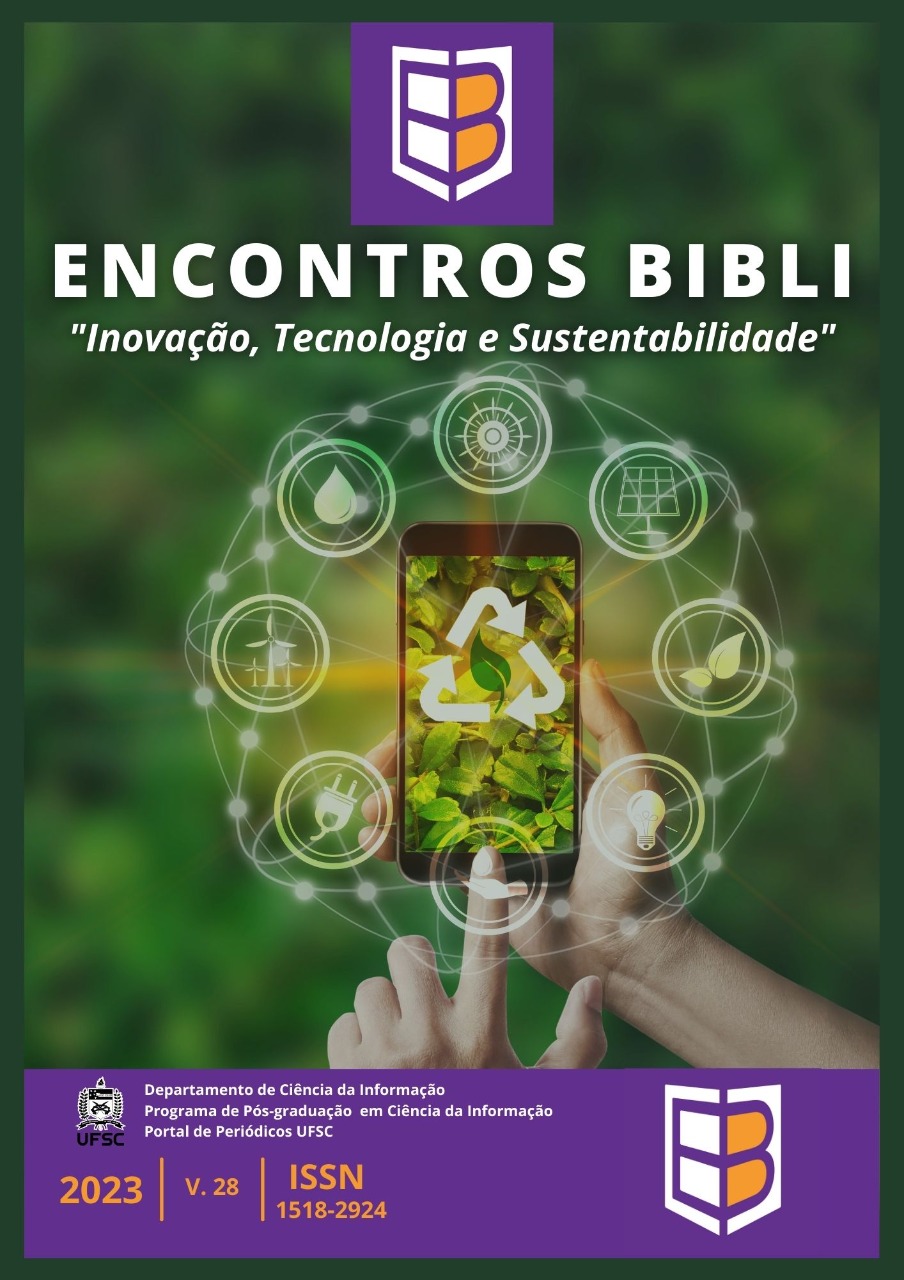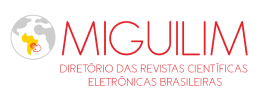Authorship concentration in health sciences journals from Latin America and the Caribbean
DOI:
https://doi.org/10.5007/1518-2924.2023.e91456Keywords:
Periodicals as Topic, Bibliometrics, Authorship, Universities, Latin America, Caribbean Region, Developing Countries, LILACS, Health SciencesAbstract
Objective: to describe authorship concentration indexes (proportion of articles by the most prolific author [PPMP]; Gini coefficient) among health sciences journals indexed in LILACS, and to compare them to what a previous study found in MEDLINE.
Methods: bibliographic data were obtained from LILACS for systematically indexed journals with at least 50 signed articles (that is, with at least one individual author) from 2015 to 2019. Authors were identified by their name or, when possible, ORCID id. The PPMP was the number articles by the journal’s most prolific author, divided by the number of signed articles. The Gini coefficient counted more than once articles with multiple authors author. For comparison purposes, MEDLINE data were reweighted to have the same distribution of journal size (number of signed articles) as LILACS journals.
Results: the study included 568 journals, with a median size of 166 signed articles. The median PPMP was 4.5% (95th percentile 12.9%), and the median Gini coefficient was 0.149 (95th percentile 0.310). The PPMP increased with journal size, while the Gini coefficient decreased. MEDLINE journals had lower PPMP and higher Gini coefficients, but this difference disappeared after the data were reweighted.
Conclusions: LILACS inclusion criteria are effectively countering any pro-endogeneity effect ownership by universities might have on regional journals. Journal evaluation should mind journal size when examining authorship concentration indexes. Formal derivation of their relationship with journal size would allow more precise interpretation of such indexes.
Downloads
References
AMORIM, K. M. DE O. et al. Evaluation Systems of Scientific Journals in Latin America. In: ALPERÍN, J. P.; FISCHMAN, G. (ed.). Made in Latin America: open access, scholarly journals, and regional innovations. Ciudad Autónoma de Buenos Aires: CLACSO, 2015. p. 61–74.
BARRADAS, J. S.; PINHEIRO, L. V. R. Produtividade científica em defesa nacional. Tendências da Pesquisa Brasileira em Ciência da Informação, [s. l.] v. 9, n. 2, p. 1-21, set./dez., 2016. Disponível em: https://revistas.ancib.org/index.php/tpbci/article/view/394/394. Acesso em: 17 ago. 2021
BEIGEL, F. et al. OLIVA: una mirada transversal a la producción científica indexada en América Latina. Diversidad disciplinar, colaboración institucional y multilingüismo en SciELO y Redalyc. [S. l.: s.n.], [2021?]. Disponível em: https://preprints.scielo.org/index.php/scielo/preprint/view/2653/version/2808. Acesso em: 17 ago. 2021.
BISHOP, D. V. M. Editorial integrity: Publishers on the front line. BishopBlog, 11 jun. 2016. Disponível em: http://deevybee.blogspot.com/2016/06/editorial-integrity-publishers-on-front.html. Acesso em: 18 maio 2023
BISHOP, D. V. M. “Percent by most prolific” author score: a red flag for possible editorial bias. BishopBlog, 12 jul. 2020.
Disponível em: http://deevybee.blogspot.com/2020/07/percent-by-most-prolific-author-score.html. Acesso em: 18 maio. 2023
BOAS, R. F. F.; CAMPOS, F. DE F.; AMARO, B. Análise dos critérios formais de qualidade editorial: a política de classificação de periódicos científicos a partir do Qualis Periódicos. Informação & Informação, Londrina, v. 26, n. 1, p. 28-52, 2021. Disponível em: https://ojs.uel.br/revistas/uel/index.php/informacao/article/view/39985. Acesso em: 18 maio 2023.
CLARK, O. A. C.; CASTRO, A. A. Searching the Literatura Latino Americana e do Caribe em Ciências da Saúde (LILACS) database improves systematic reviews. International Journal of Epidemiology, [s. l.] v. 31, n. 1, p. 112-114, fev. 2002. Disponível em: https://pubmed.ncbi.nlm.nih.gov/11914305/. Acesso em: 18 maio 2023.
COUNCIL OF SCIENCE EDITORS. CSE’s White Paper on Promoting Integrity in Scientific Journal Publications. Wheat Ridge: Council of Science Editors, 2018. Disponível em: http://www.seaairweb.info/journal/3.CouncilofScientific-Editors-White-Paper.pdf. Acesso em: 18 maio 2023.
DAVIDSON, R. Reliable inference for the Gini index. Journal of Econometrics, [s. l.], v. 150, n. 1, p. 30-40, maio 2009. Disponível em: https://www.sciencedirect.com/science/article/abs/pii/S0304407609000323. Acesso em: 18 maio 2023.
FISCHMAN, G. E.; ALPERIN, J. P.; WILLINSKY, J. Visibility and Quality in Spanish-Language Latin American Scholarly Publishing. Information Technologies & International Development, [S. l.], v. 6, n. 4, p. 1–21, dez. 2010. Disponível em: https://itidjournal.org/index.php/itid/article/view/639.html. Acesso em: 18 maio 2023.
FONTENELLE, L. F. leofontenelle/authorship-concentration: Improved analytic code for “Authorship concentration in health sciences journals from Latin America and the Caribbean”. Zenodo, 28 set. 2022. Disponível em: https://zenodo.org/record/7121200. Acesso em: 28 set. 2022.
GAGOLEWSKI, M. Stringi: Fast and Portable Character String Processing in R. Journal of Statistical Software, [s. l.], v. 103, n. 2, 2022. Disponível em: https://www.jstatsoft.org/article/view/v103i02. Acesso em: 28 set. 2022.
HELGESSON, G. et al. Editors publishing in their own journals: A systematic review of prevalence and a discussion of normative aspects. Learned Publishing, [s. l.], v. 35, n. 2, p. 229-240, 2022. Disponível em: https://onlinelibrary.wiley.com/doi/full/10.1002/leap.1449. Acesso em: 28 set. 2022.
INTERNATIONAL COMMITTEE OF MEDICAL JOURNAL EDITORS. Recommendations for the Conduct, Reporting, Editing, and Publication of Scholarly Work in Medical Journals. [S. l.], dez. 2021. Disponível em: http://www.icmje.org/recommendations/. Acesso em: 11 fev. 2022
JASSO, G. On Gini’s Mean Difference and Gini’s Index of Concentration. American Sociological Review, [s. l.], v. 44, n. 5, p. 867–870, 1979. Disponível em: https://www.jstor.org/stable/2094535. Acesso em: 11 fev. 2022.
LATIN AMERICAN AND CARIBBEAN CENTER ON HEALTH SCIENCES INFORMATION. LILACS – Criterios de Selección y Permanencia de Revistas (2020). São Paulo, 2020. Disponível em: https://lilacs.bvsalud.org/es/revistas-lilacs/lilacs-criterios-de-seleccion-y-permanencia-de-revistas-2020/. Acesso em: 18 maio. 2023.
LATIN AMERICAN AND CARIBBEAN CENTER ON HEALTH SCIENCES INFORMATION. Criteria for Selection and Permanence of Journals LILACS Brazil (2021). São Paulo, 2021. Disponível em: https://lilacs.bvsalud.org/en/lilacs-journals/criteria-for-selection-and-permanence-of-journals-lilacs-brazil-2021/. Acesso em: 18 maio. 2023.
LOCHER, C. et al. Publication by association: how the COVID-19 pandemic has shown relationships between authors and editorial board members in the field of infectious diseases. BMJ Evidence-Based Medicine, [S. l.], p. bmjebm-2021-111670, 2021. Disponível em: https://ebm.bmj.com/content/27/3/133. Acesso em: 18 maio. 2023.
MOUSSA, S. Should editors-in-chief publish in their own journals? “Publish elsewhere” is not a solution. European Science Editing, [S. l.], v. 48, p. e90552, 2022. Disponível em: https://ese.arphahub.com/article/90552/. Acesso em: 18 maio. 2023.
PAZ ENRIQUE, L. E.; PERALTA GONZÁLEZ, M. J.; HERNÁNDEZ ALFONSO, E. A. Estudio bibliométrico de la Revista Centro Agrícola, Cuba. e-Ciencias de la Información, [s. l.], v. 6, n. 2, p. 1, jun. 2016. Disponível em: https://www.redalyc.org/journal/4768/476852098002/html/. Acesso em: 18 maio. 2023.
PYATT, G. On the Interpretation and Disaggregation of Gini Coefficients. The Economic Journal, [s. l.], v. 86, n. 342, p. 243-255, 1976. Disponível em: https://www.jstor.org/stable/2230745. Acesso em: 18 maio 2023.
R CORE TEAM. R: A Language and Environment for Statistical Computing. Vienna, Austria: R Foundation for Statistical Computing, 2022.
ROZEMBLUM, C. et al. Calidad editorial y calidad científica en los parámetros para inclusión de revistas científicas en bases de datos en Acceso Abierto y comerciales. Palabra Clave (La Plata), La Plata, v. 4, n. 2, p. 64-80, abr. 2015. Disponível em: https://www.redalyc.org/pdf/3505/350539940001.pdf. Acesso em: 18 maio 2023.
SARIGÖL, E. et al. Quantifying the effect of editor-author relations on manuscript handling times. Scientometrics, [s. l.], v. 113, n. 1, p. 609-631, 2017. Disponível em: https://pubmed.ncbi.nlm.nih.gov/29056793/. Acesso em: 18 maio 2023.
SCANFF, A. et al. A survey of biomedical journals to detect editorial bias and nepotistic behavior. PLOS Biology, [s. l.], v. 19, n. 11, p. e3001133, nov. 2021. Disponível em: https://journals.plos.org/plosbiology/article?id=10.1371/journal.pbio.3001133. Acesso em: 18 maio 2023.
WICKHAM, H. Ggplot2: Elegant Graphics for Data Analysis. 2 nd. [S.l.]: Springer-Verlag New York, 2016.
WORLD ORGANIZATION OF MEDICAL EDITORS. The Relationship Between Journal Editors-in-Chief and Owners. [S. l.], 2009. Disponível em: https://wame.org/editorial-independence. Acesso em: 11 fev. 2022.
Downloads
Published
How to Cite
Issue
Section
License
Copyright (c) 2023 Leonardo Ferreira Fontenelle

This work is licensed under a Creative Commons Attribution 4.0 International License.
The author must guarantee that:
- there is full consensus among all the coauthors in approving the final version of the document and its submission for publication.
- the work is original, and when the work and/or words from other people were used, they were properly acknowledged.
Plagiarism in all of its forms constitutes an unethical publication behavior and is unacceptable. Encontros Bibli has the right to use software or any other method of plagiarism detection.
All manuscripts submitted to Encontros Bibli go through plagiarism and self-plagiarism identification. Plagiarism identified during the evaluation process will result in the filing of the submission. In case plagiarism is identified in a manuscript published in the journal, the Editor-in-Chief will conduct a preliminary investigation and, if necessary, will make a retraction.
This journal, following the recommendations of the Open Source movement, provides full open access to its content. By doing this, the authors keep all of their rights allowing Encontros Bibli to publish and make its articles available to the whole community.
Encontros Bibli content is licensed under a Creative Commons Attribution 4.0 International License.
Any user has the right to:
- Share - copy, download, print or redistribute the material in any medium or format.
- Adapt - remix, transform and build upon the material for any purpose, even commercially.
According to the following terms:
- Attribution - You must give appropriate credit, provide a link to the license, and indicate if changes were made. You may do so in any reasonable manner, but not in any way that suggests the licensor endorses you or your use.
- No additional restrictions - You may not apply legal terms or technological measures that legally restrict others from doing anything that the license permits.

























